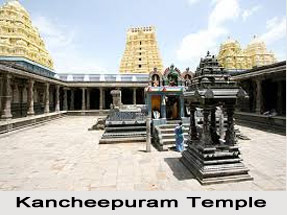 The Golden City of Kanchipuram is one of the seven sacred places of India. Kalidasa had extolled this holy centre as Nagareshu Kanchi. It is sacred for both Shaivites and Vaishnavites.
The Golden City of Kanchipuram is one of the seven sacred places of India. Kalidasa had extolled this holy centre as Nagareshu Kanchi. It is sacred for both Shaivites and Vaishnavites.
This City of Thousand Temples consists mainly of two divisions - Shiva and Vishnu Kanchi. Kanchipuram is 72 km away from Chennai.
Kamakshi Amman Temple: This is one of the 3 important Shakti Peetams, the other two being at Madurai and Kashi. The sanctum faces the Gayatri Mandapam. The beautiful deity of the Devi is in the Padmasana posture holding a bow of sugarcane and arrows of flowers. She is worshipped as Rajarajeshwari, Maha Tripura Sundari and Lalitha Kameswari.
Legend has it that the Goddess appeared through the great concavity called Bilakasa to save the Devas from Asuras. The Kamakoti Peetam or Sri Chakram, established by Sri Adi Sankara, is in front of the Goddess and all pujas are offered here.
There are separate shrines for Adi Sankara and sage Durvasa, a Devi Upasaka. During festival processions, the idol of the goddess is taken out only after formally seeking Adi Sankara`s permission. This is in fulfillment of a divine promise. Kamakshi being the principal Goddess in Kanchipuram, the Siva temples here have no separate sanctum for Shakti.
Ekambareswara Temple: Sri Ekambareswara is worshipped in the form of Prithvi Lingam (Earth). Hence Kanchipuram is considered as one of the `Pancha Bhutha Sthalas.` According to a legend, Parvati, once in Kailash, playfully closed the eyes of Lord Shiva, plunging the entire world in darkness. An angry Shiva cursed the Devi to turn dark like Kali. The Goddess descended on this place and did penance under a mango tree, making a Lingam out of earth. Hence, much significance is attached to this shrine and the mango tree that is situated within the temple.
Kailasanatha Temple: Built by Pallava king Rajasimha, this Shiva temple is known for beautiful sculptures. The image of Ardhanareeswara, seated on a bull with the feminine aspect carrying a veena, is noteworthy.
Other important shrines in Shiva Kanchi include Kachapeswara Temple, where the god appears as being worshipped by Vishnu in the form of a tortoise; Chitragupta Temple, the only one of its kind in the South; Kumara Kottam, a popular temple of Sri Subramanya; Satyavrateswara and Agastiswara shrines.
Varadaraja Perumal Temple: Situated on top of Hastigiri Hill, it is the centre of attraction in Vishnu Kanchi. The Vijayanagar kings constructed the temple, whose grand gopurams are architectural marvels. The sculptures in the Hall of Hundred Pillars arrest one`s attention.
There are separate shrines for Sri Perundevi Thayar, the divine consort, and Yoga Narasimha in a cave below Hastigiri Hill. In the holy tank known as Anantha Theertham, Lord Attigiri Varadaraja is lying below water and is taken out only once in a generation for the worship of devotees.
Other important Vishnu temples include those of Vaikunta Perumal, Ulagalanda Perumal, Ashtabhujam Perumal, Yathoktakari and Vilakkoli Perumal. Thousands of devotees converge on this temple town during Brahmotsavam, Garudotsavam and car festival.
Sri Sankara Mutt is one of the Sankara Peetams established by Sri Adi Sankara.
Kanchipuram is the home of religion besides culture, art, learning, philosophy and music. The Brindavanam of Paramacharya Sri Chandrashekharendra Saraswathi is worshipped here. The present swamijis are Sri Jayendra Saraswati and Sri Shankara Vijayendra Saraswati.











